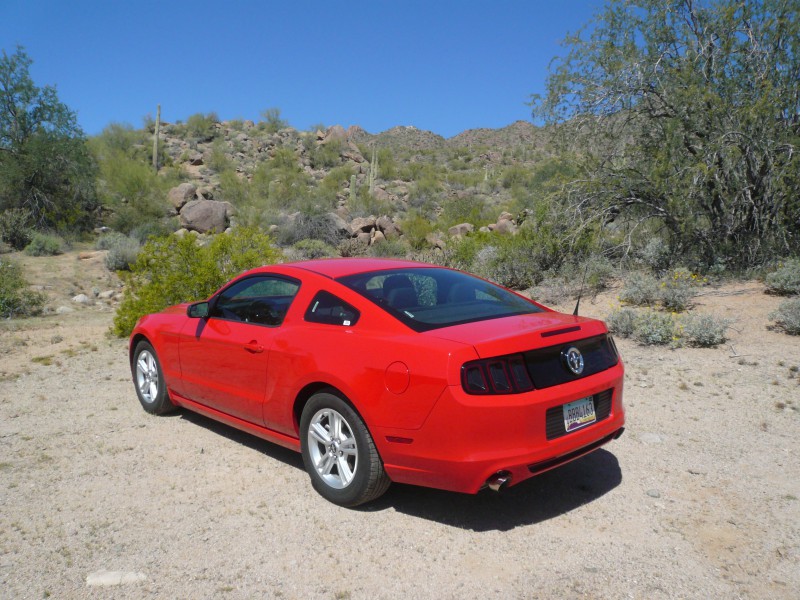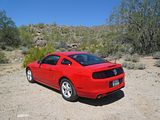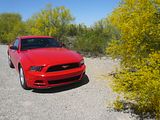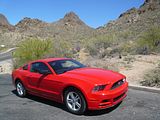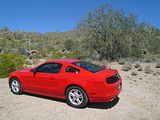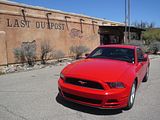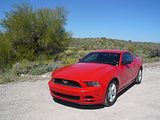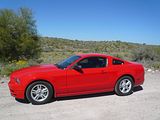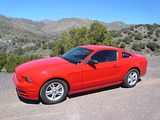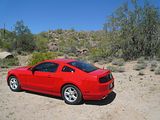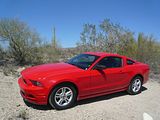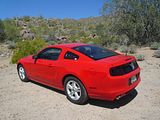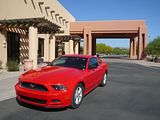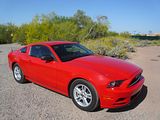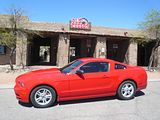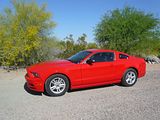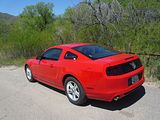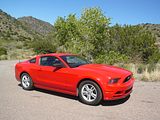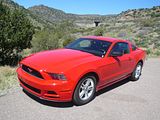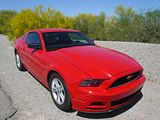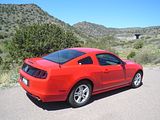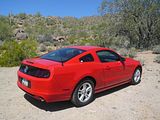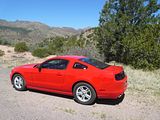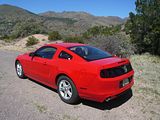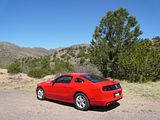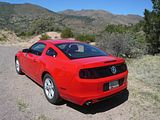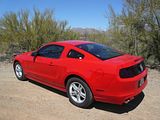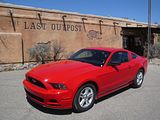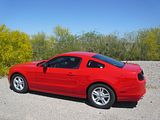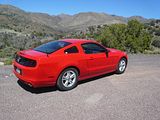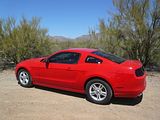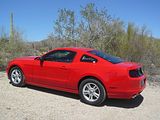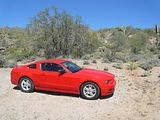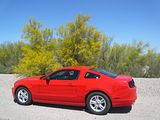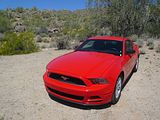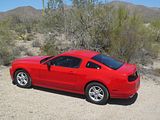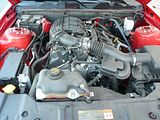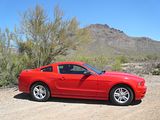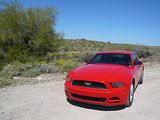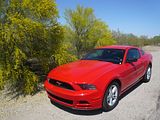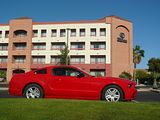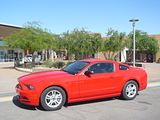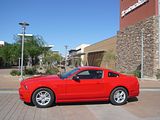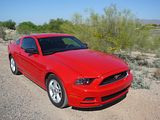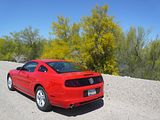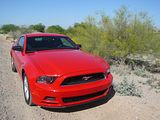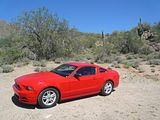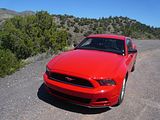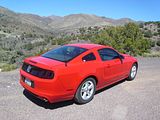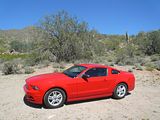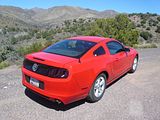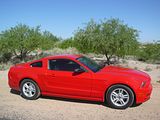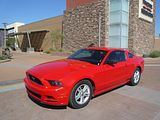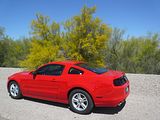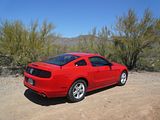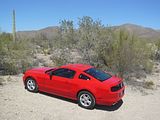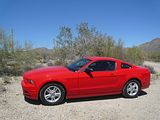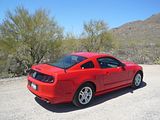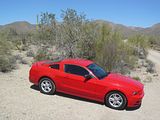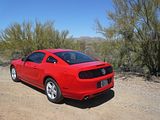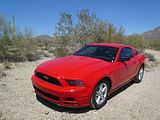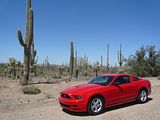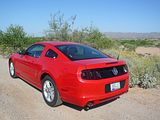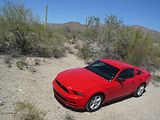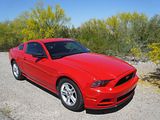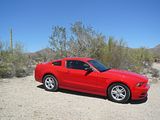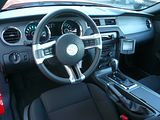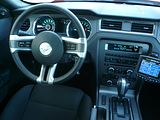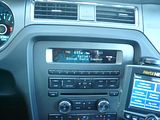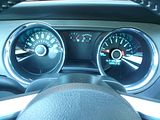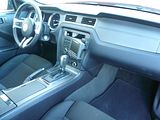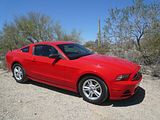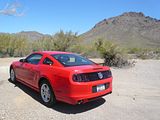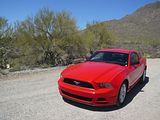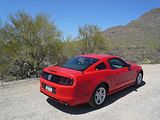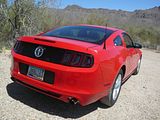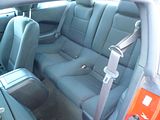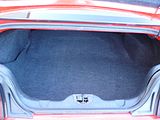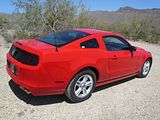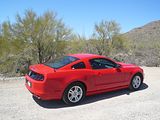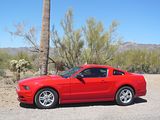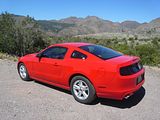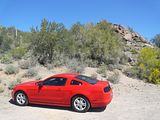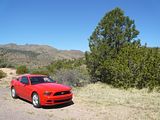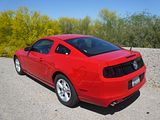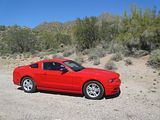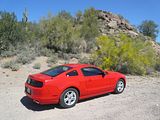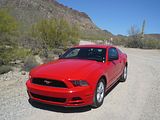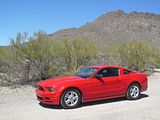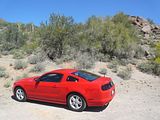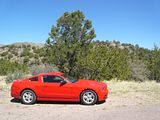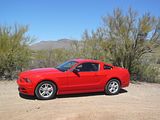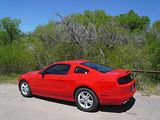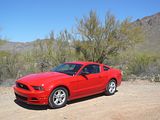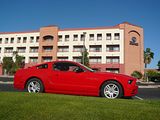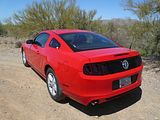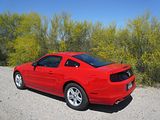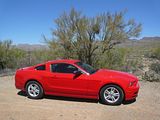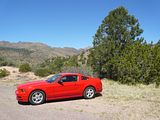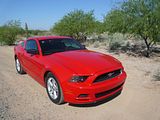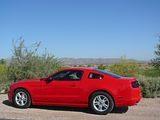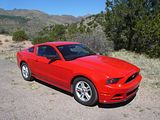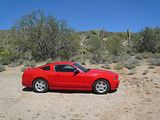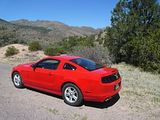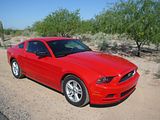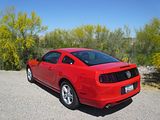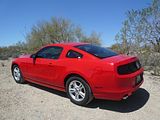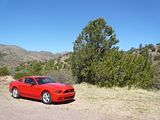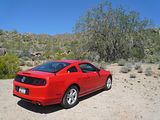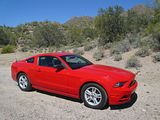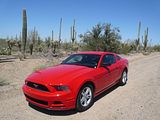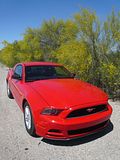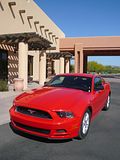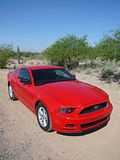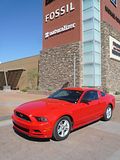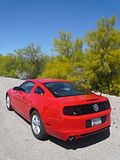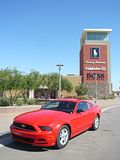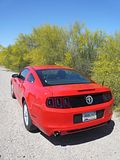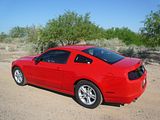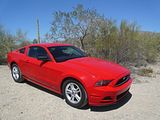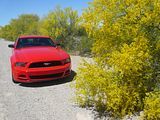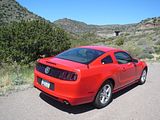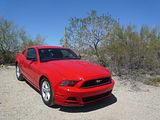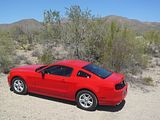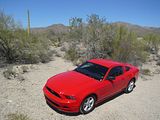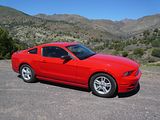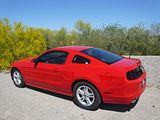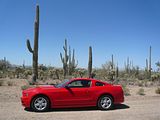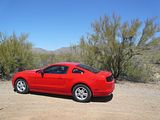

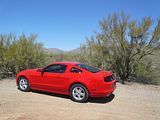
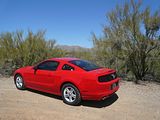
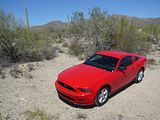
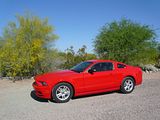
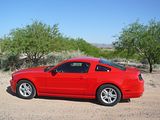
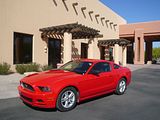
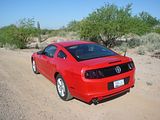
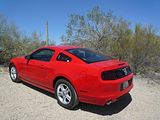
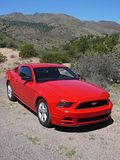
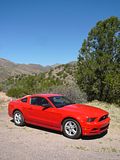
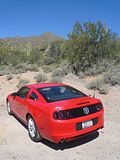
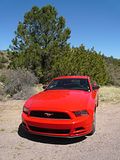
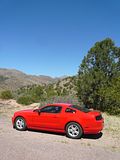
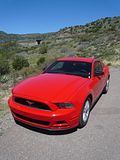
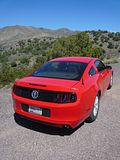
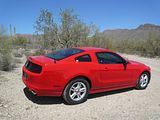
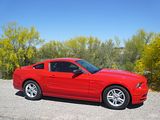
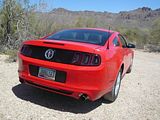
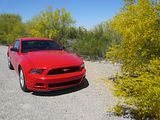
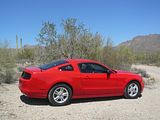
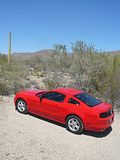
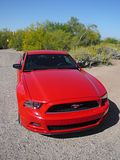
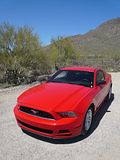
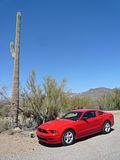
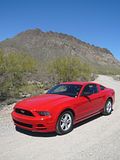
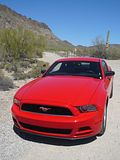
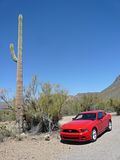
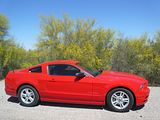
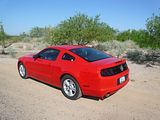
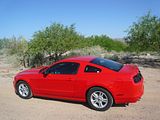
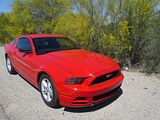
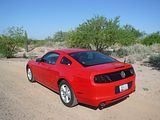
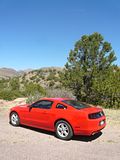
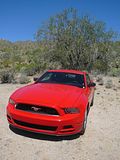
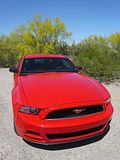
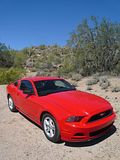
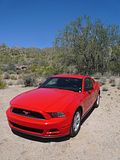
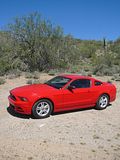
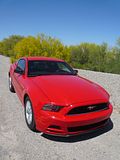
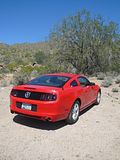
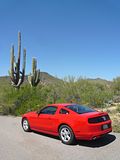
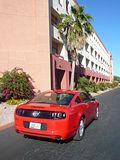
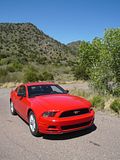
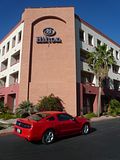
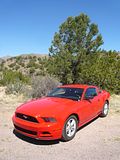
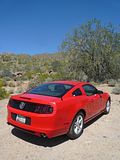
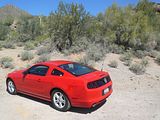
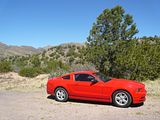
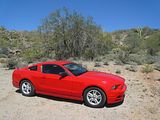
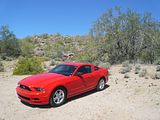
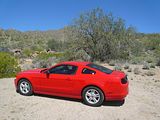
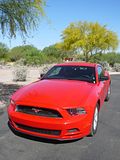
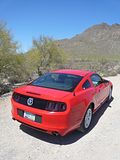
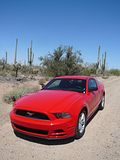
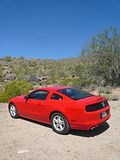
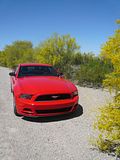
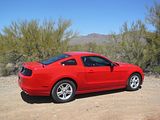
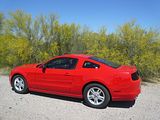
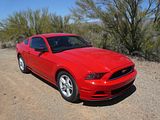
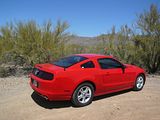
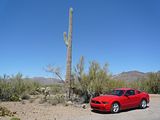
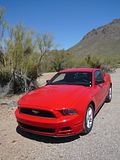
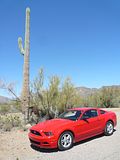
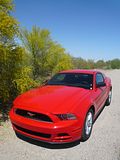
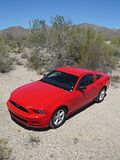
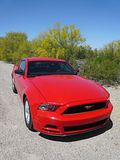
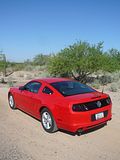
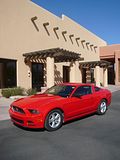
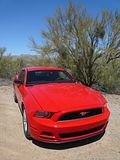
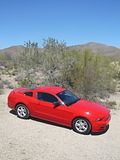
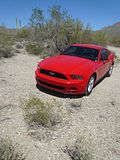
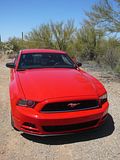

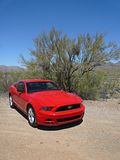
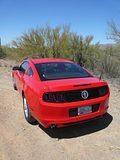
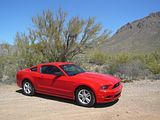
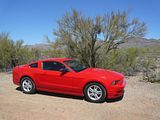
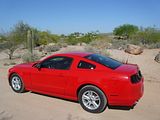
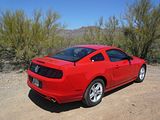
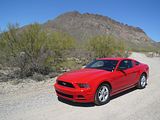
The most significant alterations to the styling and detailing came with the 2010 model year cars that launched at the 2008 Los Angeles Show, but further changes were made for the 2013 model year cars. These included a reworked front end featuring a larger grille and new splitter. The front cowl now protrudes past the headlights in a design borrowed from the 2012 Shelby GT500. All Mustang trim levels gained HIDs as standard equipment and the headlights have a cleaner look debuting two white LED-accent bars located in the headlight housing. The rear was also updated. The sequential indicator operation was retained, but stands out even more with the new rear tail light design. A high gloss panel now connects the tail lamps which now have an accentuated ringed appearance, and the rear lights are also “smoked”/blacked-out For what it is worth, I think the changes work well, and the Mustang remains a good looking design, 10 years after launch.
Over the years, Mustang has been offered in a variety of colours, many of them bright to the point of being billious. Shade have come and gone over the years, but Grabber blue has been particularly popular for several years, and it suits the car’s shape quite well. However, the only Coupe models that Hertz had a Phoenix airport when I went to collect this car were a bright scarlet colour that Ford call Race Red, and I decided that this was just the perfect shade for the car, and would also be a lot easier for the photographer than the black Nissan I had just returned. Two identical looking cars were parked alongside each other, and when I was doing the deal to get one, I expressed the preference for the one which did not have a lot of bird deposits all over the bonnet, only to notice that the other had the same problem but on the windscreen. It turns out that birds come into the facility to escape from the Arizona heat, and express their gratitude on a frequent basis by dive bombing the cars. Hertz offered to take it off for a wash if I was happy to wait, which of course I was, so that gave me the chance to hear the exhaust note of the car from the outside, and just hearing the engine fired up reminded me that I was bound to enjoy this car even though it would be significantly less powerful than the previous two Mustangs I had driven.
The 3.7 litre V6 that now sees service in the entry levels cars generates 305 bhp, which is 5 more than were put out by the old 4.6 litre V8, and 95 bhp more than were generated by the old SOHC “Cologne” 4 litre unit that was fitted to the first years of this fifth generation model Mustang. The new Duratec engine features Twin independent Variable Cam Timing (Ti-VCT) and a true dual exhaust system, which means that the unit is far more efficient, so as well as the boost to power, the intent was that economy would be significantly improved. With the new engine came new gearboxes. A Getrag 6 speed manual gearbox is standard, but in rental spec, the Mustang has Ford’s own design automatic box, but it now has 6 speeds as opposed to the 5 of the earlier spec car. Whilst the V6 is not as rapid as the GT let alone the Penske, this is still a pleasingly brisk car. The gearbox operates very smoothly, and you can pootle along in traffic very easily and then when it clears and you want to get motoring, the Mustang wakes up and heads for the proverbial hills with some alacrity. The sound deadening is such that you don’t really get the benefit of that exhaust from inside the car unless you have the windows down, but then the upside is that the Mustang is a quiet freeway cruiser, and on a long journey, you may just be grateful for that. The first Mustang Coupes that I drove had a rather unpleasant boom resonating from the rear of the car, which I was unsure was a one-off or not, but I can report that if it was a generic feature of the old car, it certainly does not afflict the current one. Although Ford claimed improved fuel economy for the Duratec engine, I got through 19 gallons of regular gas in the 399 miles that I drove the test car, which computes to a not exactly impressive 21 mpg US or 25 mpg Imperial. Whilst better than the figures you would likely achieve with the V8, they are still not good.
Although Ford have made quite a lot of changes to the other driving dynamics of the Mustang during its life time, they cannot get away from the fact that this is a car with a live rear axle, which is simply less sophisticated a way of connecting the road wheels to the body of the car, and it shows. There was a Hertz Never Lost system fitted, and although it was very securely anchored in place, every time you went over any form of bump or ridge, you could see it shake, suggesting that the body even in the Coupe model is not as rigid as you might imagine, My notes from the test record that the steering was on the light side of well judged, which means that it is not up to the same standard as you would get in a Fiesta or a Focus. The handling did not feel all that naturally tidy on swoopy roads, either. It’s certainly not wayward, unless you really provoke it, which of course I did not, as I was on public roads, but it’s not the last word in finesse. That said, the ride is generally quite comfortable, although Arizona’s smooth and well surface roads are less of a test than the awful surfaces in neighbouring California. There were no issues with the brakes. A pull up handbrake is fitted between the seats. You sit down quite low in the Mustang, so visibility is not brilliant, looking forwards all you can see if the edge of the bonnet. There are blind spot mirrors added to the door mirrors which certainly help to ensure that you are aware of what is nearly alongside you.
Seat adjustment on the Mustang is all manual, with a bar under the chair to bring it back and forth, and ratchet style levers on the side for height and backrest rake, which although meaning that the adjustments are in a series of small steps did not prove to be an undue problem. I was pleased to discover that when tilting the seat forward to allow access to the rear seats, the backrest does return to the angle you previously set. There is manual column adjustment both up and down and in and out. Even though I had the seat as low as it would go, and the column as high as possible, there is not a lot of clearance for your knees as you get in and out, and in the early part of the test, I bumped my knee on the base of the column more than once. If you have even a Hertz-sized key fob, that will hang down from the ignition slot on the right of the column and brush your knee as well. That said, the seat itself was comfortable.
The basic design of the dashboard has not changed in 10 years, but the details have, and Ford have made several efforts to improve both the perceived and the actual quality of the materials. Early cars definitely felt cheap, and whilst this one will not cause any sleepless nights at Audi, BMW or Mercedes, it is much better than it used to be. Fit and finish is now quite acceptable, and the main plastic mouldings are softer to the touch than you might guess from looking at them, though some of them are still quite hard. The instrument binnacle is squared off, and it covers the two large chrome ringed dials of speedometer and rev counter. Between these are two smaller units for fuel level and water temperature, above the display area for quite an extensive array of trip computer functions which you cycle through with a set of buttons on the left steering wheel spoke. The dials are somewhat stylised, but still easy to read. I did not find any means of changing the colour of the lighting as has been possible with some of the other Mustangs I have driven. There is just one column stalk which operates the indicators and by twisting the end, the wipers and the lights are turned on and off by a rotary dial to the left of the wheel. The original circular central air vents became rectangular with the 2008 facelift and these sit at the top of the centre of the dash, above a relatively old tech audio unit After recently encountering MyFord Touch, this came as something of a relief, as despite the rather old fashioned looking graphics on the display unit, it was very easy to operate, even though there were quite a few buttons under it which you needed to use. Some of the functions have a repeater on the steering wheel, though these buttons are very small and fiddly. Controls for the air conditioning system, a combination of rotary dials and a row of buttons are presented below this unit, and again these were easy to use, though not that easy to access when stationary as they are too close to the gearlever when it is in Park.
One thing that has not changed during the 10 year life of this generation of Mustang is the packaging. There are four seats, though I would not like to be the person that has to ride in the back for every far. There are definitely only two rear seats, with not just the transmission tunnel acting as deterrent to trying to squeeze in a third occupant, but the two seats are set much lower than a sort of raised area where the cushion would be. Getting in requires a modicum of agility, as only the front seat backrest tilts forward, leaving a fairly tight space between this and the door pillar through which you need to clamber. Once there, how much legroom these passengers get will depend on how far forward or not the front seats are. Sitting behind myself, so to speak, legroom was not an issue, but I left the front passenger seat well back, and the backrest more reclined, and this all but removed any space for rear passenger legs. Headroom is limited, too. I found my head touching the rear screen. Having said all that, there is more space in here than the back of an Audi TT, but if you want a modern-day pseudo muscle car, you really do need to look at the Dodge Challenger to find one that will accommodate four people in comfort. So, assuming there are only two people, then the boot will probably be generous enough. The boot lid itself is relatively small, so the problem is more around the size of the opening than the actual capacity. I did manage to squeeze my suitcase through, and once it was in, there was ample space for it and quite a lot more luggage besides. There is a space saver under the boot floor, and you could tuck a few odds and ends around that. I believe the rear seat backrests should fold down, but I could not reach the release cables easily to try it. There is no external release, so you either need to press the release on the key fob or a button on the centre console to gain access. Inside the cabin, there is a modest glovebox, a bit of space in a cubby under the central armrest, and some very tiny door pockets, and that is it, so not particularly generously provided with space for odds and ends.
Mustang is offered with Coupe and Convertible bodies and with a choice of the 3.7 litre V6 or 5 litre V8 engines. In addition, Ford have what is currently the world’s most potent V8 engine, the 662 bhp 5.8 litre Shelby GT500 The “regular” cars are available in Standard and Premium trim. A regular V6 starts at $22,510, while for an extra $4100, the Premium adds a different design of 17″ alloy wheel, Recaro leather sports front seats withe driver’s one 6 way power adjustable, the cursed Sync and a 4.2″ display with MyColor (that is the feature which allows you to change the ambient lighting), a leather wrapped steering wheel, aluminium trim inserts, bright rather than black coloured pedals, a Shaker audio system with XM satellite radio and a universal remote garage door opener, Both models have dual exhaust pipes, solar tinted glass, air conditioning, cruise control, power door mirrors with the integrated blind spot mirrors, HID headlights, Ford’s MyKey system, the Ford Message Center display in the dashboard and split folding rear seats in the Coupe, and the standard model has an AM/FM audio unit with CD, AUX port and MP3 capability that lacks the XM satellite function, even though there was a button to press to select it. There are all manner of other optional packages, ranging from the purely cosmetic to ones which will change some of the driving characteristics. Of the latter, the most significant for the V6 models is the Performance Package, which adds the following: choice of automatic or manual transmissions (coupe only); Strut-tower brace; larger front sway bar and SVT rear sway bar; unique front springs; unique front and rear calipers with performance friction pads; 19” painted aluminium wheels; 255/40-19 summer-only tyres; unique stability control calibration; Gloss black side mirrors; 3.31 limited-slip rear axle. Equipment levels for the GT and Shelby cars are broadly similar. Most of the extra money you pay for these goes on upgraded mechanicals.
10 years is a long time to keep a car in production these days, and it speaks volumes for the appeal of this fifth generation model that whilst sales peaked early in its career and have tailed off gradually ever since 2005, it is still competitive, and driving one will bring a smile to many an owner and any vacationer who gets the chance to rent one. By keeping the Mustang relatively simple, the price has remained at an affordable level. Ford have done what they can to update the car during its lifetime, but there is no doubt that there are some things which can only really be addressed by a complete model replacement. And of course, that is happening later this year. The all-new 2015 model, with independent rear suspension, and a global sales ambition was premiered in December 2013, and will go on sale in America in the 4th quarter of 2014, before reaching other world markets. It is a car that everyone is itching to sample. But in the mean time, if., like me, you see a bright red (or for that matter, any other colour) at the car rental place when you are on your American odyssey, then if you sign it to take it on a drive, I think you will enjoy the experience. I certainly did. My decision to drive the 7th example of the Mustang was unquestionably a good one.

